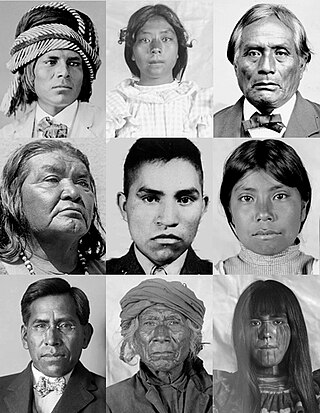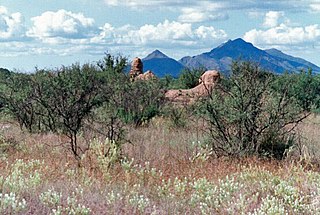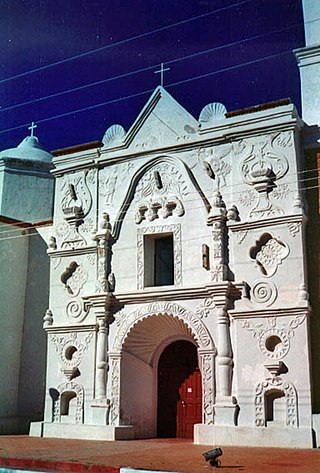
The Pima Revolt, also known as the O'odham Uprising or the Pima Outbreak, was a revolt of Pima native Americans in 1751 against colonial forces in Spanish Arizona and one of the major northern frontier conflicts in early New Spain.

The Pima Revolt, also known as the O'odham Uprising or the Pima Outbreak, was a revolt of Pima native Americans in 1751 against colonial forces in Spanish Arizona and one of the major northern frontier conflicts in early New Spain.
The revolt culminated from decades of violence by the local Spanish settlers against Indians beginning in 1684. The period was characterized by local Indians' gradual loss of autonomy and territory. Treaties allowing the Spanish to mine and herd on Native lands led to an influx of new settlers; by 1760, Hispanos had become a substantial presence in the present-day American Southwest. However, the colonial province of Sonora was characterized by a larger native population, and more frequent conflict between them and the Spaniards. [1] The Pima Indian Revolt was directly preceded by the Seri Revolt of Seri Indians in Sonora. [2]
While the Pima people had no central authority, the charismatic Luis Oacpicagigua (Luis of Sáric) began the task of uniting—with varying degrees of success—the disparate groups, numbering at least 15,000 people, under a single war plan. The initial act of rebellion was the massacre of 18 settlers lured to Oacpicagigua's home in Sáric on November 20th, 1751. [2] [3] Over the next day, uprisings followed in Caborca, Pitiquito, Oquitoa, Atil, Tubutama, Sonoyta, Busani, Agua Caliente, Baboquivari, Arivaca, and Tubac; more than a hundred settlers were killed. [3]
Oacpicagigua surrendered to Captain José Díaz del Carpio on March 18, 1752 after a negotiated peace. When the Pima leaders laid the blame for the revolt on Jesuit missionaries (who would be expelled from Spain and its colonies in 1767), they were pardoned by the colonial governor Ortiz Parrilla. [2]
Small scale conflict soon began again, however, and Oacpicagigua eventually died in a Spanish prison in 1755. The colonial government founded three new presidios in Sonora to control the Pima and Seri populace in the years after the revolt: San Ignacio de Tubac, Santa Gertrudis de Altar, and San Carlos de Buenavista, present-day Tubac, Arizona, Altar, Sonora, and Buenavista, Sonora, respectively. [4] While intermittent rebellions continued, by the end of the eighteenth century, Sonoran natives had been largely missionized or Hispanicized, and the assimilated tribes of frontier New Spain were absorbed into the Spanish Empire.

The Tohono Oʼodham are a Native American people of the Sonoran Desert, residing primarily in the U.S. state of Arizona and the northern Mexican state of Sonora. The United States federally recognized tribe is the Tohono Oʼodham Nation.

The Pimería Alta was an area of the 18th century Sonora y Sinaloa Province in the Viceroyalty of New Spain, that encompassed parts of what are today southern Arizona in the United States and northern Sonora in Mexico.

The Akimel O'odham, also called the Pima, are a group of Native Americans living in an area consisting of what is now central and southern Arizona, as well as northwestern Mexico in the states of Sonora and Chihuahua. The majority population of the two current bands of the Akimel O'odham in the United States are based in two reservations: the Keli Akimel Oʼodham on the Gila River Indian Community (GRIC) and the On'k Akimel O'odham on the Salt River Pima-Maricopa Indian Community (SRPMIC).
Indigenous peoples of Arizona are the Native American people who currently live or have historically lived in what is now the state of Arizona. There are 22 federally recognized tribes in Arizona, including 17 with reservations that lie entirely within its borders. Reservations make up over a quarter of the state's land area. Arizona has the third largest Native American population of any U.S. state.
The O'odham,Upper Oʼodham, or Upper Pima are a group of Native American peoples including the Akimel O'odham, the Tohono Oʼodham, and the Hia C-eḍ Oʼodham. Their historical territory is in the Sonoran desert in southern and central Arizona and northern Sonora, and they are united by a common heritage language, the O'odham language. Today, many O'odham live in the Tohono O'odham Nation, the San Xavier Indian Reservation, the Gila River Indian Community, the Salt River Pima-Maricopa Indian Community, the Ak-Chin Indian Community or off-reservation in one of the cities or towns of Arizona.

The Spanish missions in the Sonoran Desert are a series of Jesuit Catholic religious outposts established by the Spanish Catholic Jesuits and other orders for religious conversions of the Pima and Tohono O'odham indigenous peoples residing in the Sonoran Desert. An added goal was giving Spain a colonial presence in their frontier territory of the Sonora y Sinaloa Province in the Viceroyalty of New Spain, and relocating by Indian Reductions settlements and encomiendas for agricultural, ranching, and mining labor.

Mission San José de Tumacácori is a historic Spanish mission near Nogales, Arizona, preserved in its present form by Franciscans in 1828.

Tubac Presidio State Historic Park, located in Tubac, Arizona, US, preserves the ruins of the Presidio San Ignacio de Tubac and various other buildings, thereby presenting a timeline of European settlement in this Southern Arizona town. The park contains a museum, a number of historic sites, an underground archeology exhibit displaying the excavated foundations of the Tubac Presidio, and a picnic area. Various cultural events are held on-site throughout the year, including Anza Days (October), Los Tubaqueños living history presentations, archeological tours, and nature walks. Until recently, the park was administered by Arizona State Parks but is the first park in the Arizona state park system. As a result of budget cutbacks, the Tubac Presidio was scheduled to be closed in 2010, but was rescued by local residents and the Tubac Historical Society. It is now operated by The Friends of the Presidio and staffed with dedicated volunteers.

La Misión de San Gabriel de Guevavi was founded by Jesuit missionary priests Eusebio Kino and Juan María de Salvatierra in 1691. Subsequent missionaries called it San Rafael and San Miguel, resulting in the common historical name of Mission Los Santos Ángeles de Guevavi.

Mission San Cayetano de Calabazas, also known as Calabasas, is a Spanish Mission in the Sonoran Desert, located near present-day Tumacacori, Arizona, United States.

Mission San Pedro y San Pablo del Tubutama is a Spanish mission located in Tubutama, Sonora, first founded in 1691 by Eusebio Francisco Kino.

The Presidio of San Ignacio de Túbac or Fort Tubac was a Spanish built fortress. The fortification was established by the Spanish Army in 1752 at the site of present-day Tubac, Arizona. Its ruins are preserved in the Tubac Presidio State Historic Park.

Altar is a municipality in the Mexican state of Sonora in north-western Mexico. The municipality had a 2010 census population of 9,049 inhabitants, the vast majority of whom lived in the municipal seat of Altar, which had a population of 7,927 inhabitants. There are no other localities with over 1,000 inhabitants.

Presidio San Agustín del Tucsón was a presidio located within Tucson, Arizona, United States. The original fortress was built by Spanish soldiers during the 18th century and was the founding structure of what became the city of Tucson. After the American arrival in 1846, the original walls were dismantled, with the last section torn down in 1918. A reconstruction of the northeast corner of the fort was completed in 2007 following an archaeological excavation that located the fort's northeast tower.
Luis Oacpicagigua or Luis of Sáric was a Pima leader in the Spanish province of Sáric, now the far north of the Mexican state of Sonora.
Between the years of 1539 and 1821, the Spanish Empire explored, colonized, and ruled over what is the state of Arizona in the United States.
Ignacio Xavier Keller was a Jesuit missionary to Mexico at Mission Santa María Suamca. His treatment of Pima leader Luis Oacpicagigua was an inciting factor in the Pima Revolt of 1751.
Joseph Garrucho (1712–1785) was a Jesuit missionary to Mexico, who served at Mission Los Santos Ángeles de Guevavi and Mission San Miguel Arcángel de Oposura. He was implicated in the events leading up to the Pima Revolt of 1751.
Jabanimó or Hawani Mo'o was an Akimel O'odham leader involved in Native American uprisings during the 1750s, possibly including the 1751 Pima Revolt.